This is featured post 1 title
Replace these every slider sentences with your featured post descriptions.Go to Blogger edit html and find these sentences.

This is featured post 2 title
Replace these every slider sentences with your featured post descriptions.Go to Blogger edit html and find these sentences.

This is featured post 3 title
Replace these every slider sentences with your featured post descriptions.Go to Blogger edit html and find these sentences.

vendredi 30 novembre 2007
N82 Support Pages
Adding Active Standby Plugins
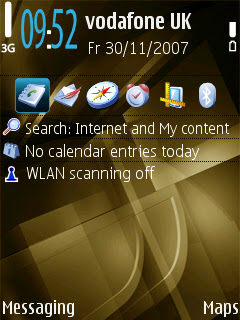 You can see from the screenshot the standard standby screen, on my N82. There are the 6 Active Standby shortcuts, and three functions listed below, Search, Calendar and WLAN.
You can see from the screenshot the standard standby screen, on my N82. There are the 6 Active Standby shortcuts, and three functions listed below, Search, Calendar and WLAN. What I would like to see Nokia incorporate into NSeries and standard S60 phones is the Active Standby plug-ins found on ESeries phones. I really don't see why it can't be included for most phones in a firmware update. The plug-ins allow you to choose which options are listed under the shortcut icons. You can remove all shortcut options under the icons, if you wish, you can add features such as message inbox details, add voicemail alert details, etc. My friend Neil from Mobile Venue has just picked up a Nokia N95 8GB and one of the first things he wanted was to remove the calendar, and search.
I've had a few comments and emails when I posted about this back in March and it is often talked about in forums.
If this is a feature you would like to see added to S60 phones across the board, click on this link and add your voice to the S60 application wishlist. Rate the idea, add a comment, and if enough people show they want this feature, maybe Nokia will implement it for us.
p.s. I saw the theme used in the screenshot here and here. It's now my default theme.
mardi 27 novembre 2007
Nokia N95 reaches one million milestone in the UK
The N95 is one of the most featured smartphones released by Nokia to date, and has regularly topped retail best sellers lists. N95 features include a 5.0 megapixel camera, WiFi, web browser, bespoke multi media keys and built in GPS.
Andrew Connell, head of multimedia, Nokia UK, said:
"The Nokia N95 has more than lived up to the hype around its launch as one of the must-have gadgets this year – sealed by hitting the one million sales mark."
"The N95 not only looks good, but also packs a punch by delivering on a groundbreaking features set that takes mobile communication to a new level in convergence devices."
lundi 26 novembre 2007
N95 V 2.0 firmware available
Improvements include demand paging, faster operation and new camera software amongst other things.
Check out the AllAboutSymbian page for more info and screenshots.
vendredi 23 novembre 2007
Nokia N82 battery performance
Norman John over at the Symbian World blog has put his N82 through its paces to see how well his battery stood the test. Click here for the post.
GyPSii Mobile client available
GyPSii is a geo-location and social networking platform for mobile and internet connected devices. The service is already available for windows mobile devices and now includes Symbian support.
Visit www.gypsii.com to download the mobile client.
Source
jeudi 22 novembre 2007
Nokia N82 V Nokia N73 Camera test
Nokia N73
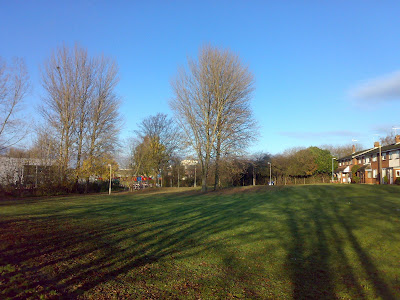
Nokia N82
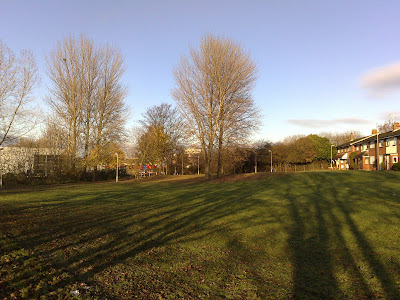
Nokia N73
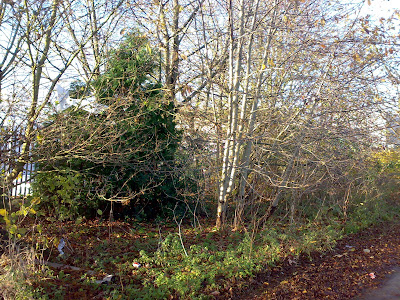
Nokia N82

Nokia N73

Nokia N82

The following two pictures are taken in macro:
Nokia N73

Nokia N82

The next two pictures were taken indoors, with the flash on:
Nokia N73

Nokia N82

These last two pictures were taken indoors, without flash:
Nokia N73
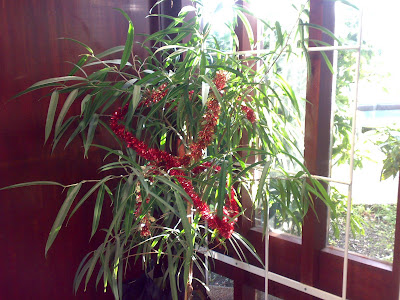
Nokia N82
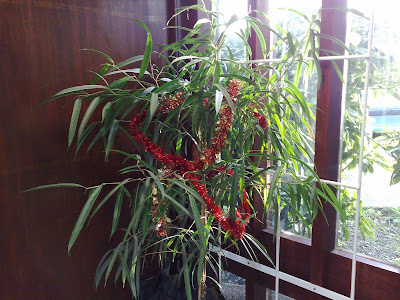
What do you think? From my point of view, there's not a lot in it. So, camera wise, the N73 seems to hold its own. But add in all the other things the N82 offers, such as camera speed (The N73 is painfully slow to load the camera in comparison) menu browsing speed, the fact that the N82 is S60v3FP1, the N82 has the motion sensor, WiFi, GPS, etc the N82 pulls away. Add in to that the battery is as good as the N73, and I really can't see a reason not to upgrade.
New firmware available for N95 8GB
Check the thread out for comments from people once they've updated.
mercredi 21 novembre 2007
NSeries PC Suite is back
Anyway, the PC Suite can be downloaded here, you can tell Nokia what you think by leaving a comment on Tommi's blog here and over at AllAboutSymbian you can read about the new release with screenshots too.
mardi 20 novembre 2007
Nokia N82 v Sony Ericsson K850i
This picture was taken on macro mode:
Nokia N82

SE K850i
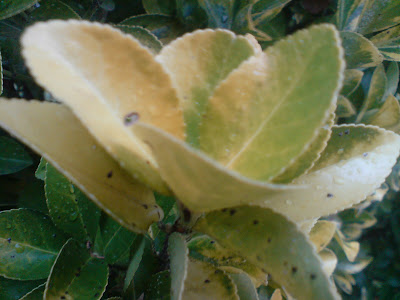
The next two pictures are taken on standard setting:
Nokia N82
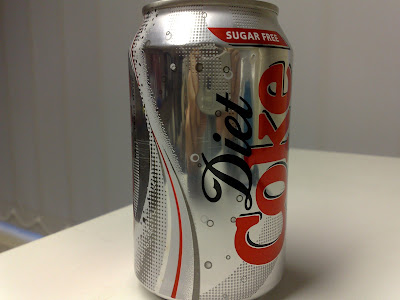
SE K850i
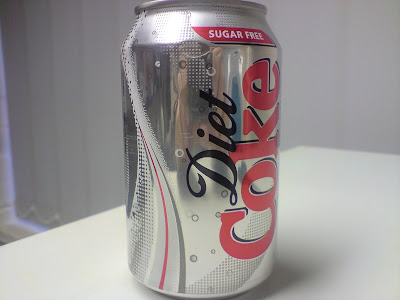
Nokia N82

SE K850i
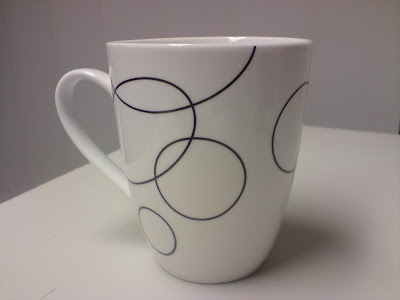
I think the results are clear enough. Chalk another one up for the Nokia N82.
Edit: After reading through the comments it seems the EXIF data isn't showing for these pictures, and also the picture size isn't what would be expected from a 5.0 megapixel camera. So, I've uploaded the images to Flickr, where all EXIF data is available and image properties show properly.
Click here to access the Flickr set.
lundi 19 novembre 2007
Envoyer un sms en j2me

Voici une Midlet qui permet l'envoi et la réception de sms.
import javax.microedition.midlet.*;
import javax.microedition.io.*;
import javax.microedition.lcdui.*;
import javax.wireless.messaging.*;
import java.io.IOException;
public class SMSMIDlet
extends MIDlet
implements CommandListener, Runnable {
private Sender mSender = null;
private Thread mReceiver = null;
private Command mExitCommand = new Command("Exit", Command.EXIT, 2);
private Command mRedCommand = new Command("Send Red", Command.SCREEN, 1);
private Command mBlueCommand = new Command("Send Blue", Command.SCREEN, 1);
private Display mDisplay = null;
protected ImageItem mColorSquare = null;
protected Image [] mImages = new Image[2];
protected Image waitImage = null;
private String mPort = "1234";
private TextField mNumberEntry= null;
private Form mForm = null;
private String mSenderAddress = null;
public SMSMIDlet() {
mSender = Sender.getInstance();
}
public void commandAction(javax.microedition.lcdui.Command c,
javax.microedition.lcdui.Displayable d) {
if (c == mExitCommand) {
if (!mSender.isSending()) {
destroyApp(true);
notifyDestroyed();
}
} else if (c == mRedCommand) {
String dest = mNumberEntry.getString();
if (dest.length() > 0)
mSender.sendMsg(dest, mPort, "red");
} else if (c == mBlueCommand) {
String dest = mNumberEntry.getString();
if (dest.length() > 0)
mSender.sendMsg(dest, mPort, "blue");
}
}
protected void destroyApp(boolean param) {
try {
mEndNow = true;
conn.close();
} catch (IOException ex) {
System.out.println("destroyApp caught: ");
ex.printStackTrace();
}
}
protected void pauseApp() {
}
protected void startApp() {
if (mForm == null) {
mForm = new Form("SMSMIDlet");
mNumberEntry = new TextField("Connect to:",
null, 256, TextField.PHONENUMBER);
try {
mImages[0] = Image.createImage("/red.png");
mImages[1] = Image.createImage("/blue.png");
waitImage = Image.createImage("/wait.png");
} catch (Exception ex) {
System.out.println("startApp caught: ");
ex.printStackTrace();
}
mColorSquare = new ImageItem(null, waitImage,ImageItem.
LAYOUT_DEFAULT, "colored square");
mForm.append(mNumberEntry);
mForm.append(mColorSquare);
mForm.addCommand(mExitCommand);
mForm.addCommand(mRedCommand);
mForm.addCommand(mBlueCommand);
mForm.setCommandListener(this);
}
Display.getDisplay(this).setCurrent(mForm);
startReceive();
}
private void startReceive() {
if (mReceiver != null)
return;
// Start receive thread
mReceiver = new Thread(this);
mReceiver.start();
}
private boolean mEndNow = false;
private MessageConnection conn = null;
public void run() {
Message msg = null;
String msgReceived = null;
conn = null;
mEndNow = false;
/** Check for sms connection. */
try {
conn = (MessageConnection) Connector.open("sms://:" + mPort);
msg = conn.receive();
while ((msg != null) && (!mEndNow)) {
if (msg instanceof TextMessage) {
msgReceived = ((TextMessage)msg).getPayloadText();
if (msgReceived.equals("red")) {
Display.getDisplay(this).callSerially(new SetRed());
} else if (msgReceived.equals("blue")) {
Display.getDisplay(this).callSerially(new SetBlue());
}
}
msg = conn.receive();
}
} catch (IOException e) {
// Normal exit when connection is closed
}
}
class SetRed implements Runnable {
Display disp = null;
public void run() {
mColorSquare.setImage(mImages[0]);
}
}
class SetBlue implements Runnable {
public void run() {
mColorSquare.setImage(mImages[1]);
}
}
}Comment tester l'envoi de SMS :
Vous pouvez facilement tester SMSMIDlet, ou toute application SMS, à l'aide d'un utilitaire appelé le WMA présent dans WTK 2.x. .Pour accéder à la console de WMA, sélectionnez "files" puis "utilities" . Cliquez ensuite la console WMA, puis sélectionnez "launch".
Pour tester SMSMIDlet, d'abord démarrer une instance dans l' émulateur.
Quand il démarre. Notez que sur la barre de titre de l'émulateur un numéro de téléphone apparait, ce dernier commence par Un "+" , Par défaut, c'est le +5550000, C'est le numéro de l'émulateur.
Maintenant, lancez la console de WMA, Sélectionnez le numéro de l'émulateur, cliquez sur le bouton "send SMS".
Worldmate Pro Update Available
 Worldmate is an excellent app and for a while now has been available free to S60 users. The application has a Weather forecaster, world clocks, Global Weather cast and a World Day/Night map. If you do decide to upgrade to the full version, you also get access to Flight Schedule information, real time flight status and satellite weather imagery.
Worldmate is an excellent app and for a while now has been available free to S60 users. The application has a Weather forecaster, world clocks, Global Weather cast and a World Day/Night map. If you do decide to upgrade to the full version, you also get access to Flight Schedule information, real time flight status and satellite weather imagery. To download direct to your handset enter http://mobile.mobimate.com/s60 into your phones browser, otherwise if you want to download to your PC and transfer the app over click here
vendredi 16 novembre 2007
Nseries-Mobile Nokia N82 Review
.jpg) The Nokia N73 is one of the best handsets ever released in the NSeries range, and has been my main phone since it first hit the market. I've tried over phones, other Nokia handsets, other NSeries, handsets from Motorola and handsets from Sony Ericsson. Most recently I purchased an N95, but even that went in favour of my N73, as I mentioned back in July. The N73 just gives a good solid all round package. It is reliable, dependable, has a very good quality camera, is well built, solid, and hard working. It is simple and straight forward to use, and has a battery that just goes on and on. I know when I leave home for the day I can listen to music on the phone, do some web browsing whilst I'm out and about, view some email, make some calls, send text, just the ordinary things you do on a daily basis with a modern mobile phone these days and the battery won't run down. I've never been caught out without power on my N73, unlike past handsets, like the N80 and N95. My N73 has served me well, and it would take something very good to tempt me away. And something especially has arrived.
The Nokia N73 is one of the best handsets ever released in the NSeries range, and has been my main phone since it first hit the market. I've tried over phones, other Nokia handsets, other NSeries, handsets from Motorola and handsets from Sony Ericsson. Most recently I purchased an N95, but even that went in favour of my N73, as I mentioned back in July. The N73 just gives a good solid all round package. It is reliable, dependable, has a very good quality camera, is well built, solid, and hard working. It is simple and straight forward to use, and has a battery that just goes on and on. I know when I leave home for the day I can listen to music on the phone, do some web browsing whilst I'm out and about, view some email, make some calls, send text, just the ordinary things you do on a daily basis with a modern mobile phone these days and the battery won't run down. I've never been caught out without power on my N73, unlike past handsets, like the N80 and N95. My N73 has served me well, and it would take something very good to tempt me away. And something especially has arrived..jpg) Hello Nokia N82. You will have seen from previous posts below, I was at the launch of the N82 in Finland this week. Along with Stefan, from Intomobile, Devin from TheNokiaGuide, Pseudofinn from NokiaUsers, Mark from TheNokiaBlog and the guys from Womworld, we were able to see the virtual launch from inside Nokia house. A once in a lifetime experience, not only did we lucky few get to be inside Nokia house whilst the launch happened, we also got to question the N82 product manager and get our hands on the handset there and then to put it to the test. When you have a bunch of guys together, who know their phones, and are big fans of Nokia and NSeries products, you need to be confident your product is going to be good enough. With all due respect to our hosts and all, if the N82 failed to hit the mark, we would have let them know, how and why. As it turned out the N82 team have a handset they can be proud of, and all of us found it hard to let go of our phones for the rest of the day. Straight away we were installing apps, taking pictures, making calls, browsing the net, testing the features, giving the handset a real going over. The overall impression of the phone was very good, and you could see the delight we all had when our hosts kindly allowed us to take the handset away with us to really put the N82 to the test, in every day usage.
Hello Nokia N82. You will have seen from previous posts below, I was at the launch of the N82 in Finland this week. Along with Stefan, from Intomobile, Devin from TheNokiaGuide, Pseudofinn from NokiaUsers, Mark from TheNokiaBlog and the guys from Womworld, we were able to see the virtual launch from inside Nokia house. A once in a lifetime experience, not only did we lucky few get to be inside Nokia house whilst the launch happened, we also got to question the N82 product manager and get our hands on the handset there and then to put it to the test. When you have a bunch of guys together, who know their phones, and are big fans of Nokia and NSeries products, you need to be confident your product is going to be good enough. With all due respect to our hosts and all, if the N82 failed to hit the mark, we would have let them know, how and why. As it turned out the N82 team have a handset they can be proud of, and all of us found it hard to let go of our phones for the rest of the day. Straight away we were installing apps, taking pictures, making calls, browsing the net, testing the features, giving the handset a real going over. The overall impression of the phone was very good, and you could see the delight we all had when our hosts kindly allowed us to take the handset away with us to really put the N82 to the test, in every day usage. .jpg) To get straight to the point, the Nokia N82 is a damn fine phone. Very often with a new phone you will find little niggles, something that doesn't work as well as you would expect, or something missing that would have seemed a logical inclusion. It's still early days, but so far the N82 is proving to be a reliable top notch handset. The design is good. The phone feels well built, has a solid feel and is well balanced, with good weight distribution. One of the most important parts of a mobile phone is the keypad. Without a decent keypad, a phone fails. The keypad on the N82 is different, very reminiscent of the W880i from Sony Ericsson, but as the keys are not as cramped as they are on a W880i they are much more user friendly. Sending a text message on the N82 is simple and straight forward, and the keypad is an improvement over the cramped layout found on the N73.
To get straight to the point, the Nokia N82 is a damn fine phone. Very often with a new phone you will find little niggles, something that doesn't work as well as you would expect, or something missing that would have seemed a logical inclusion. It's still early days, but so far the N82 is proving to be a reliable top notch handset. The design is good. The phone feels well built, has a solid feel and is well balanced, with good weight distribution. One of the most important parts of a mobile phone is the keypad. Without a decent keypad, a phone fails. The keypad on the N82 is different, very reminiscent of the W880i from Sony Ericsson, but as the keys are not as cramped as they are on a W880i they are much more user friendly. Sending a text message on the N82 is simple and straight forward, and the keypad is an improvement over the cramped layout found on the N73. Down the right hand side of the phone you find near the top the micro USB port, in the middle the Micro SD slot and near the bottom the charging port. The N82 doesn't charge via the USB cable. All you find on the bottom of the phone is the microphone. Then, going up the left hand side of theh andset, at top and bottom are the speakers, in between which there is the camera shutter key, gallery shortcut key and volume keys, which double up as zoom keys when in camera mode. The Nokia N82 has a 3.5mm jack point, which you can use with your own headphones for music listening. In a smart move, Nokia have placed this on the top of the phone, so when the phone is in your pocket the headphone lead sits naturally on top. The lanyard slot is on the top right hand corner of the phone, right next to the 3.5mmm slot.
.jpg) The N82 is designed for 'technology stylists', people who like their phone to look good but don't want to lose out on features. The main focus of the phone is the excellent 5.0 megapixel camera. The camera is equipped with autofocus, a Xenon flash and a Carl Zeiss lens. The lens is covered by a protective cover, which when flicked open automatically activates the camera. The response time is very fast, in no time the camera is active and ready for use. There are various camera options in the settings menu, for changing scene mode, adjusting colour options, white balance, etc. When a picture is taken it stores very quickly. Press the capture button again after taking a pic and almost instantly the N82 is ready for the next shot. The speed is very impressive. The N82 has a large, TFT, QVGA screen supporting up to 16 million colours. As a viewfinder for the camera the whole screen is used and the clarity is superb. Browsing around phone forums and other blogs in the last day I've seen some people complain about the small size of the screen. Personally I think it is more than adequate, and a bigger screen would also mean a bigger phone. That would have upset the balance of the handset.
The N82 is designed for 'technology stylists', people who like their phone to look good but don't want to lose out on features. The main focus of the phone is the excellent 5.0 megapixel camera. The camera is equipped with autofocus, a Xenon flash and a Carl Zeiss lens. The lens is covered by a protective cover, which when flicked open automatically activates the camera. The response time is very fast, in no time the camera is active and ready for use. There are various camera options in the settings menu, for changing scene mode, adjusting colour options, white balance, etc. When a picture is taken it stores very quickly. Press the capture button again after taking a pic and almost instantly the N82 is ready for the next shot. The speed is very impressive. The N82 has a large, TFT, QVGA screen supporting up to 16 million colours. As a viewfinder for the camera the whole screen is used and the clarity is superb. Browsing around phone forums and other blogs in the last day I've seen some people complain about the small size of the screen. Personally I think it is more than adequate, and a bigger screen would also mean a bigger phone. That would have upset the balance of the handset.The N82 is very fast, considerally quicker than any S60 phone I have used to date. From boot up, the N82 accesses straight into the menu without any noticeable delay. Anyone who has used a S60 phone will know that this is not usually the case. Menu navigation is quick and snappy, and the D-Pad is easy to use. I've installed quite a few apps and I will talk about that in a separate post.
 There are some nice touches in the menu system. The Active Standby screen has the usual six icons which can be changed to suit your own choice. Underneath the icons is the standard calendar entries, plus a shortcut to the WiFi scan and the search feature. This is all good, but just a quick point, on an old favourite hobby horse of mine. Please, Nokia, include on the NSeries phones the excellent Active Standby Plugins found on ESeries handsets. I posted about it here after finding out about it on the E65. It just enhances the user experience that little bit more.
There are some nice touches in the menu system. The Active Standby screen has the usual six icons which can be changed to suit your own choice. Underneath the icons is the standard calendar entries, plus a shortcut to the WiFi scan and the search feature. This is all good, but just a quick point, on an old favourite hobby horse of mine. Please, Nokia, include on the NSeries phones the excellent Active Standby Plugins found on ESeries handsets. I posted about it here after finding out about it on the E65. It just enhances the user experience that little bit more.The search option on the N82 is very good. Highlight the shortcut option from the standby screen:

Once selected you are presented with the screen of available search options. You can go straight to the internet to search, or search through content on the phone.
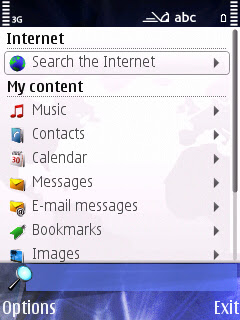
You can scroll down to the selected option, in this case bookmarks:

A simple flick to the right opens all bookmarks on the phone:

All options in search work in a similar way. It makes browsing through contacts, notes, messages, etc, simple and straight forward.
Simple and straight forward is a good line for this phone. Not simple in features, just simple to use. Another nifty feature is the small option key, found on the front above the C key. Pressing this takes you by default to the last picture taken on the phone, with an option to view a slide show of pictures or view albums on the front tab. There are 7 tabs which are scrolled through in a kind of carousel design:

The tabs can be reset into the order you prefer. The tabs available are Gallery, Music, Videos, Games, Maps, Internet and contacts.
There is so much more on the N82. I've used it on Vodafone and Orange so far and had excellent HSDPA connections on both. Data transfer is fast, downloaded from the net and to/from PC via the USB cable. The N82 has an integrated GPS chip and also supports A-GPS. Lock on time is less than 10 seconds. The antenna is at the top of the phone, which makes sense as most people will use the phone in car in a phone holder. The N82 also supports Bluetooth 2.0 so will work with compatible Bluetooth headsets for wireless music playback, and there is support for W-Lan too.
It's been a while since I've been so impressed with a phone, straight from the off. There have been no freezes, no memory errors, no glitches. The N82 is that good that I don't want to go back to using my N73. And trust me it takes a damn good handset for that to happen.
jeudi 15 novembre 2007
N82 Camera Pictures
Nokia N82 Review
Link
N82 Promo videos
mercredi 14 novembre 2007
Back from Finland - Nokia N82
.jpg)
.jpg)
.jpg)
Charger un TiledLayer en J2me

Un TiledLayer est un élément visuel composé d'une grille de cellules qui peuvent être remplis d'un ensemble de parties d'images.
Cette technique est couramment utilisée pour la réalisation de jeux java 2D sur téléphone .
Le code source suivant est celui de la classe DemoCanvas.java, pour pouvoir tester cet exemple et le faire fonctionner il faudra penser à créer une midlet qui fera appel à cette classe, je suppose que c'est assez simple donc nous n'allons pas en parler ici.
Code source J2me :
package exemple2;
import javax.microedition.lcdui.*;
import javax.microedition.lcdui.game.*;
import java.io.IOException;
/**
*
* @author java-Mobile
*/
public class DemoCanvas extends GameCanvas {
/** Creates a new instance of DemoCanvas */
protected DemoCanvas() {
super(true);
initLayer();
drawBackground();
}
public void initLayer() {
int backgroundWidth = 10;
int backgroundHeight = 10;
int tileWidth = 32;
int tileHeight = 32;
Image tilesImage = null;
try {
tilesImage = Image.createImage("/exemple2/modele.png");
} catch (IOException ex) {
throw new RuntimeException ("Unable to load Image - "+ex);
}
TiledLayer tiledLayer = new TiledLayer(
backgroundWidth, backgroundHeight,
tilesImage, tileWidth, tileHeight);
int[] map = {
1 , 5 , 5 , 5 , 5 , 5 , 5 , 4 , 4 , 4 ,
4 , 5 , 5 , 5 , 5 , 5 , 5 , 5 , 5 , 4 ,
4 , 5 , 5 , 5 , 2 , 2 , 5 , 5 , 5 , 4 ,
4 , 5 , 5 , 5 , 2 , 2 , 5 , 5 , 5 , 4 ,
4 , 4 , 5 , 5 , 2 , 2 , 5 , 5 , 5 , 4 ,
4 , 4 , 4 , 5 , 5 , 2 , 2 , 2 , 5 , 4 ,
1 , 1 , 3 , 3 , 5 , 5 , 2 , 2 , 5 , 4 ,
3 , 1 , 3 , 3 , 3 , 5 , 5 , 5 , 5 , 4 ,
3 , 1 , 1 , 3 , 3 , 3 , 5 , 5 , 1 , 1 ,
3 , 3 , 1 , 1 , 1 , 1 , 1 , 1 , 1 , 3 ,
3 , 3 , 3 , 3 , 3 , 3 , 3 , 3 , 3 , 3 };
for (int y=0; y
for (int x=0; x
tiledLayer.setCell(y, x, map[y*backgroundWidth+x]);
}
}
setTiledLayer(tiledLayer);
}
public void drawBackground() {
// Get off-screen buffer
Graphics g = getGraphics();
// Clear the background
g.setColor(BACKGROUND_COLOR);
g.fillRect(0, 0, getWidth(), getHeight());
// Paint the tiled layer
TiledLayer tiledLayer = getTiledLayer();
if(tiledLayer != null) {
tiledLayer.paint(g);
}
}
public TiledLayer getTiledLayer() {
return tiledLayer;
}
public void setTiledLayer(TiledLayer tiledLayer) {
this.tiledLayer = tiledLayer;
}
private TiledLayer tiledLayer;
public static final int BACKGROUND_COLOR = 0x00000000;
}
Plus d'infos sur la Class TiledLayer
mardi 13 novembre 2007
J2me comment afficher une image?
package exemple1;
import javax.microedition.midlet.*;
import javax.microedition.lcdui.*;
import javax.microedition.lcdui.*;
import java.io.IOException;
public class Affiche extends MIDlet {
private Display _display;
private Moteur _moteur;
public Affiche()
{
_moteur = new Moteur();
_display = Display.getDisplay(this);
}
class Moteur extends Canvas
{
private int _height,_zoneH;
private int _width,_zoneW;
public Moteur()
{
_height = getHeight();
_width = getWidth();
_zoneW = _width -5 ;
_zoneH = _height -5;
}
protected void paint(Graphics g)
{
//g.setColor(0);
g.fillRect(0, 0, _width, _height);
Image source;
try
{
source = Image.createImage("/exemple1/tux2.png");
}
catch (IOException e)
{
throw new RuntimeException ("Unable to load Image - "+e);
}
g.drawImage(source, _height/2, _width/2, Graphics.VCENTER|Graphics.HCENTER);
}
}
protected void keyPressed(int keyCode)
{
}
protected void keyReleased(int keyCode)
{
}
public void startApp() {
_display.setCurrent(_moteur);
}
public void pauseApp() {
}
public void destroyApp(boolean unconditional) {
}
}
un portage de Java sur l'iPhone ??

La communauté Java open source espère qu'Apple introduira la version phoneME de Java ME dans le SDK (kit de développement logiciel) de l'iPhone attendu pour le début 2008, c'est ce que sous entend Terrence Barr "évangéliste technique" pour la Java mobiles et systémes embarqués, de chez apple.
Source : web2linux
dimanche 11 novembre 2007
Un kit de développement pour l'iphone

William Hurley adore son iPhone. Mais il l'aimerait encore plus s'il pouvait créer pour lui des logiciels sur mesure. Et il n'est pas le seul. Des centaines de programmeurs ont pointé leur nez à un événement iPhone organisé par William Hurley, cadre dirigeant de l'éditeur de logiciel BMC, bien qu'Apple n'ait pas encore révélé le code source dont tous ces programmeurs ont besoin pour exploiter l'appareil. C'était en juillet, et depuis, les critiques soulevées par le refus d'Apple d'ouvrir l'iPhone restent vives.
Il semble toutefois qu'Apple leur donnera bientôt satisfaction. Selon des sources informées de la stratégie de l'entreprise, un kit de développement logiciel pour l'iPhone sortira au début de l'année 2008, permettant ainsi aux programmeurs de créer des jeux, des logiciels de gestion, ainsi qu'un nombre infini d'applications diverses et variées pour cet appareil. On ignore les détails, mais d'après nos sources, une annonce sera faite en janvier, probablement le 15, lors de l'allocution du pdg d'Apple, Steve Jobs, à la Macworld Expo de San Francisco.
Pourquoi cette attente ? Selon certains analystes, ce retard ne vise pas à frustrer les éditeurs. Il n'est pas dû non plus à la crainte de voir des logiciels tiers provoquer des bugs susceptibles de mettre en danger les réseaux de téléphonie portable. Il semblerait plutôt qu'Apple ait souhaité attendre au moins jusqu'au lancement du nouveau système d'exploitation des ordinateurs Macintosh. Connu sous le nom de code Leopard , ce système devait être dévoilé en juin 2007, mais il est sorti fin octobre. L'iPhone ayant été créé sur la base de la version Mac OS actuelle, les nouvelles possibilités offertes par Leopard permettront également d'intégrer à l'iPhone des fonctionnalités plus musclées.
Source : http://www.lepoint.fr
Création de la Premiére Midlet

Comme tout débutant on va commencer par la création de la Midlet hello world .
Voici la procédure sous eclipse, c'est à peu prés le méme principe que sous Netbeans :
- Tout d'abord commencer par créer un nouveau projet de type
« J2ME/J2ME Midlet Suite ».
- Cliquez sur le bouton « Suivant ».
- Donner un nom à votre projet puis cliquez sur le bouton « Suivant ».
- Sélectionnez la plate-forme et cliquez sur le bouton « Suivant ».
- Cliquez sur le bouton « Fin » pour créer le projet.
- Ensuite il faudra ajouter une midlet en créant une nouvelle entité de type
« J2ME/J2ME Midlet ».
- Cliquez sur le bouton « Suivant ».
- Là on spécifie le dossier source, le nom du package ainsi que le nom de notre Midlet genre BonjourMidlet.
Tout ce qui est écrit en noir est générée par le compilateur, le reste ce qui est écrit en vert est le code à taper.
package test; import javax.microedition.midlet.*;
import javax.microedition.lcdui.*;
public class BonjourMidlet extends MIDlet {
private Display display;
private TextBox textbox;
public BonjourMidlet() {
super();
display = Display.getDisplay(this);
textbox = new TextBox("", "Bonjour", 20, 0);
}
/* (non-Javadoc)
* @see javax.microedition.midlet.MIDlet#startApp()
*/
protected void startApp() throws MIDletStateChangeException {
display.setCurrent(textbox);
}
/* (non-Javadoc)
* @see javax.microedition.midlet.MIDlet#pauseApp()
*/
protected void pauseApp() {
// TODO Raccord de méthode auto-généré
}
/* (non-Javadoc)
* @see javax.microedition.midlet.MIDlet#destroyApp(boolean)
*/
protected void destroyApp(boolean arg0) throws MIDletStateChangeException {
// TODO Raccord de méthode auto-généré
}
} 
Ensuite pour tester la Midlet sur votre téléphone mobile aller récupérer le .jar et .jad qui se situent dans votre espace de travail dans le répertoire "dist" (si vous utilisrr Netbeans).
si vous êtes sous Eclipse faites un click droit sur votre projet puis exporter jar et laisser vous guider.
une fois le .jad et .jar générer consulter la page ICI pour savoir comment transférer votre application sur votre téléphone mobile.
Transférer jeux et applications java sur votre mobile

Une question revient souvent comment télécharger mon jeu java ou ma midlet (application java) sur mon téléphone mobile ?
Tout d'abord pour déployer une application ou un jeu que vous venez de développer vous devez avant générer le .jad et .jar.
Une fois le .jad et .jar générer, plusieurs possibilités de déploiement s'offre à nous mais ceci dépend du modèle du téléphone :
1.1 Transfert bluetooth :
- Cas problématique d'un téléphone Samsung:
Une fois que vous avez fini de télécharger l'application ou le jeu sur votre téléphone mobile vérifier qu'il est bien présent dans votre répertoire "other files", si c'est le cas, il nous faut accéder au menu secret de Samsung pour installer le jeu ou la midlet pour ceci taper *#9998*5282# puis 3 pour accéder au formulaire "install midlet" ensuite taper le code secret 235282 .
1.2 Transfert Par Internet (wap) :
Une solution fort intéressante, utile et pratique est le déploiement par internet (wap), en effet plusieurs sites offre la possibilité d'uploader votre .jad et .jar.
On peut citer:
http://www.plogg.net/ploggwallet.php
- Une fois l'upload fait, le site en question fournit un lien et un identifiant + un code.
- Avec le navigateur wap du téléphone mobile vous accéder au lien, puis vous entrez les identifiant et voilà comme par magie le jeu ou l'application commence à se télécharger et le téléphone l'installe automatiquement.
Ce type de déploiement est utile pour les modèles Samasung ou autres modèles qui interdisent les autres types de déploiement.
Outils de Développement


Dans cet article on va traiter des outils de développement sous Windows, on peut citer deux environnements de développement Netbeans et Eclipse, avant de se pencher sur les outils de développement, nous allons nous intéresser aux pré-requis nécessaires pour commencer tout développement J2ME.
I. Pré-requis:
1. JDK:
Télécharger le SDK, non le JRE.
2. Java Wireless Toolkit :
Le java wireless toolkit de chez sun offre quelques outils rudimentaires de configuration et de gestion du code. Mais surtout il comprend des émulateurs de terminaux mobiles.
http://java.sun.com/products/sjwtoolkit/download-2_2.html .
Une fois Le JDK et le Java wireless Toolkit installé nous allons nous pencher sur les outils de développement.
II. Outils de développement :
1. Eclipse :
est un environnement de développement libre (le terme Eclipse désigne également le projet correspondant, lancé par IBM) extensible, universel et polyvalent, permettant potentiellement de créer des projets de développement mettant en œuvre n'importe quel langage de programmation. Eclipse IDE est principalement écrit en Java.
pour télécharger Eclipse c'est ici : Eclipse
1.1 EclipseMe :
C'est le plug-in propre à eclipse qui permet le développement d'applications J2ME reposant sur MIDP en utilisant un Wireless Toolkit.
Les fonctionnalités proposées par ce plug-in sont :
- Le support de plusieurs Wireless Toolkit
- Un assistant de création de projets de type Midlet Suite
- Un assistant de création de Midlets
- Un éditeur pour les fichiers .jad
- Une compilation incrémentale avec pré-vérification
- Le débogage du code des Midlets
- L'exécution dans les émulateurs fournis avec le WirelessToolkit
- La création d'un package pour les applications J2ME
- La création d'un package obscurci avec Proguard
- Le support du mode « Over The Air »
Le site officiel de ce plug-in est à l'url : http://eclipseme.org/
1.2 Installation :Une fois le pack eclipseMe télécharger il suffit alors de suivre les étapes suivantes :
- Utilisez l'option « Mise à jour de logiciels/Rechercher et installer » du menu Aide.
- Sélectionnez « Rechercher les nouveaux dispositifs à installer » et cliquez sur le bouton « Suivant ».
- Cliquez sur le bouton « Nouveau site archivé »
- Sélectionnez le fichier et cliquez sur « Ouvrir »
- Dans l'arborescence des sites, sélectionnez eclipseme.feature_x.x.x_site.zip et cliquez sur le bouton « Suivant »
- Sélectionnez les dispositifs « EclipseMe » et « eclipseme.features.siemens »
- Lisez la licence et si vous l'acceptez cliquez sur « J'accepte les termes du contrat » et cliquez sur le bouton « Suivant »
- Cliquez sur le bouton « Fin »
- Lors de l'affichage de la boîte de dialogue « Vérification du dispositif », cliquez sur le bouton « Installer »
- Acceptez de relancer le plan de travail.
2. Netbeans :
Netbeans est un environnement de développment pour java, placé en open source par Sun sous licence CDDL . En plus de Java, NetBeans permet également de supporter différents autres langages.
Il comprend toutes les caractéristiques d'un IDE moderne (éditeur en couleur, projets multi-langage, refactoring, éditeur graphique d'interfaces et de pages web).
NetBeans est lui-même développé en Java, ce qui peut le rendre assez lent et gourmand en ressources mémoires.
Pour télécharger Netbeans c'est ici : http://www.netbeans.info/downloads/index.php
C'est le plug-in propre à Netbeans qui permet le développement d'applications J2ME reposant sur MIDP en utilisant un Wireless Toolkit .
Pour télécharger le Mobility Pack c'est ici : http://www.netbeans.org/kb/50/mobility.html
Java Mobile Information

Introduction :
La plateforme Java 2 Micro Edition (J2ME) a été créée pour le marché de consommateur d'équipement à ressources limitées de mémoire et de processeur tels que : téléphones portables, smart cartes, palms, organizers et mini-ordinateurs.
Java Mobile (J2ME) permet de lancer Java sur l'équipement ayant des ressources limitées. Pour cet objectif, J2ME adapte la technologie de Java qui existe. Voyons 3 points de J2ME : la configuration, les profiles et le Midlet. L'information détailler vous pouvez trouver sur le site officiel de Sun Microsystems: http://java.sun.com/j2me/
1. La configuration
Elle détermine le milieu d'exécution de J2ME. Elle inclut une machine virtuelle limitée par rapport à VM standard et d'un nombre des classes principales, en général, empruntées à J2SE.Actuellement, il y a 2 configurations déterminées : configuration des mobiles de communication à ressources limitées (Connected Limited Device Configuration, CLDC) et configuration des mobiles de communication (Connected Device Configuration, CDC). La première configuration est orientée vers le mini mobile équipé de processeurs à 16/32 bits dont le mémoire est de 128 KB minimum.Le point avantageux de J2ME CLDC consiste en une machine virtuelle K Virtuel Machine (KMV), mise au point spécialement pour les interfaces de réseau à mémoire et ressources limitées. La deuxième configuration de J2ME CDC est orientée vers les modèles électroniques prévues à être montés à l'intérieur, plus compliqués tels que : smart communicateurs, pagers, PDA, (Sony PlayStation, XBox, etc.). Normalement, les mobiles pareils inclus les processeurs à 32 bits fonctionnant comme contrôleur et de mémoire de plus de 2 Mb utilisé pour sauvegarder la machine virtuelle et la bibliothèque. CDC met en marche la machine virtuelle C Virtuel Machine (CVM).
CDC est composé de toutes les classes de CLDC et contient encore plus de classes de J2SE. La différence principale entre CDC et CLDC est ce que CDC VM maintient toutes les possibilités de J2SE VM y compris native programming interfaces.






















 02:26
02:26
 matine salim
matine salim



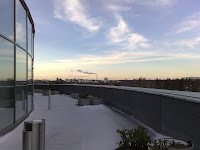
.jpg)










